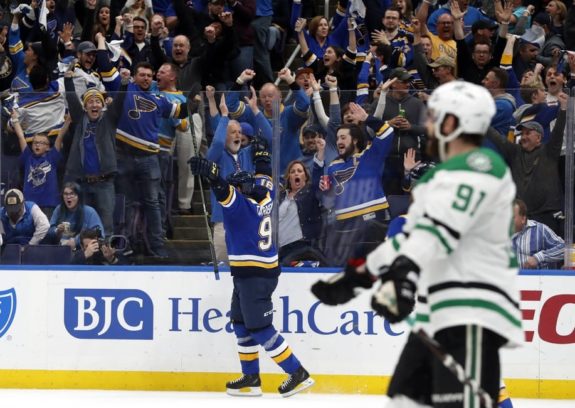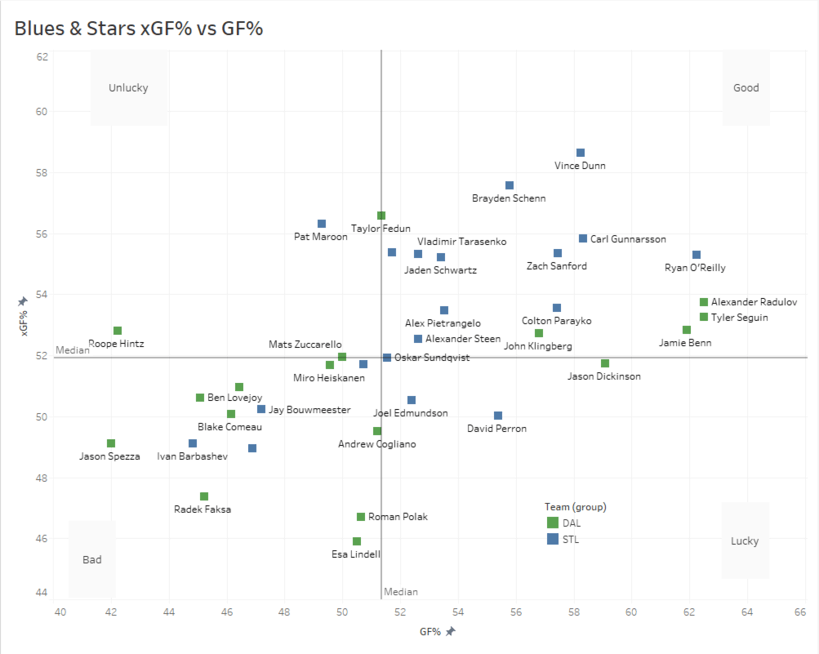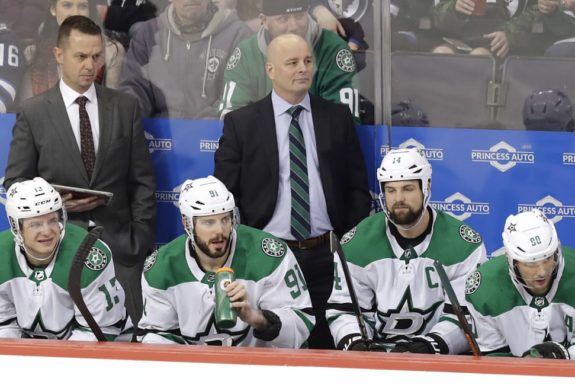The St. Louis Blues’ primary asset is depth. Their roster is full of players who create offensive chances while they are on the ice. As I mentioned in a previous article, this depth can allow the Blues to create mismatches amongst most opponents. In their second round playoff series versus the Dallas Stars, this depth could help give them an edge over the Stars.

Stars Do Not Have Blues’ Depth
The Stars coach Jim Montgomery was quoted as saying he believes the Blues and Stars are mirror images of each other. This simply is not an accurate characterization of the two teams. The Stars primarily have one exceptional forward line comprised of Tyler Seguin, Jamie Benn, and Alexander Radulov that creates the majority of their chances. Outside of that top line, they simply cannot match the Blues’ firepower. Below is a chart showing the Blues and Stars players ranked by Expected Goals For Percentage (xGF%), showing how many chances are created, and Goals For Percentage (GF%), showing how many goals a player actually created while they were on the ice.

A player is doing very well if they find themselves in the top right corner. The Stars’ top line is at the high end of GF% and is doing well in terms of xGF%. There are no other Stars’ forwards in the top right corner of the chart, but there are six Blues’ forwards.
On defense, the two teams each have a few of their regular defensemen in the top right corner. However, the Stars have a much larger percentage of their defensemen in the bottom left corner, meaning they are creating less opportunities than their opponents and giving up more goals. The Blues’ depth can expose these defensive pairings.
Series Is About More Than Depth
Do not get me wrong, it is not a foregone conclusion that the Blues will beat the Stars. The Stars have the top end talent in Benn, Seguin, and Radulov to beat the Blues. Additionally, John Klingberg is the biggest offensive threat on defense for either team. He made a couple of plays in Game 1 that gave the Blues a lot of trouble.
In order for the Stars to get the better of the play in this series, they will have to stick to their strengths. In the third period of Game 1, with the Stars trailing the Blues 3-1, Stars coach Jim Montgomery moved Benn off the top line and onto the second line. The Stars were having trouble matching the Blues’ depth, and it clearly was an attempt to spread around the Stars’ depth. This seemed to work in the third period, as the Stars clearly carried the play. However, I tend to think this was largely caused by score effects, and the desperation of playing from behind.

The Stars beat the Nashville Predators in the first round because of their top line, and their high-end skill level. Meanwhile, the Blues continue to use Jay Bouwmeester on their top defensive shutdown unit with Colton Parayko. Bouwmeester’s advanced statistics were sub-par in the regular season, and that pairing was exposed in the first round against the Winnipeg Jets’ top line. The Stars have an opportunity to exploit that weakness to an even higher degree than the Jets did.
However, if the Stars decide to split up their top line, that will give the Blues an advantage on just about every line matchup. The Blues’ top line of David Perron, Ryan O’Reilly, and Vladimir Tarasenko can more than match-up against a weakened Stars’ first line. Additionally, the Stars’ second line, even with Benn on it, is not much of a match for the Blues’ second line of Jaden Schwartz, Brayden Schenn, and Oskar Sundqvist.
The Better Strategy Will Win the Series
The Blues are the better team when it comes to the 12 forwards and six defensemen each team will put on the ice. However, this series will be won by the team that sticks to its strengths and executes its strategy to a higher degree. The Blues continue to put themselves at a disadvantage by leaning on Bouwmeester too much. The Stars’ top line could completely expose that disadvantage. If they combine that mismatch with the exceptional goaltending we have seen from Ben Bishop, then they could very well steal the series.